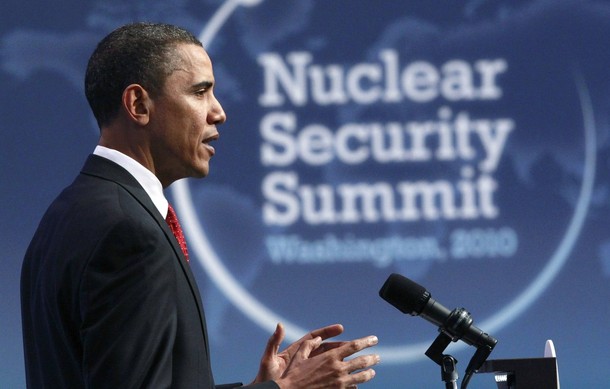
This has been another extraordinary week for U.S. President Barack Obama. The release of the Nuclear Posture Review; the signing of the nuclear arms reduction treaty with Russia; and the nuclear security conference in which more heads of state were convened by a U.S. president since Franklin Roosevelt proposed the San Francisco conference to establish a United Nations in 1945 were singular accomplishments. All could lead to a “nuclear spring.”
Twenty-five or 30 years ago, the threat of nuclear war prompted the prediction of a so-called nuclear winter, which would be an end to civilization as we knew it following thermonuclear war.
A made-for-television movie graphically depicted the effects of a nuclear winter that turned the United States into a barren and unlivable land. Fortunately, neither East nor West was reckless or foolish enough to allow that catastrophe to happen.
Now, given the past week, the prospect of a “nuclear spring,” which reduces or eliminates the likelihood of using any form of nuclear destructive power through international cooperation, has taken a large step forward.
The Nuclear Posture Review correctly aimed to align strategy and policy with the realities of today and the uncertainties of tomorrow.
The “right” accused this review of eroding deterrence by not guaranteeing the threat of a U.S. nuclear response against all weapons of mass destruction attacks. The major fear was that Iran or North Korea might provide a nuclear weapon to a third party and thus have plausible deniability after such a device were used against the United States or its friends, fears that are decades old and were misapplied to the Soviet Union and Red China.
But nuclear materials have definite finger prints and, as happened after Sept. 11, 2001, and Pearl Harbor, anyone who assumes American passivity is making a profoundly colossal error.
The latest START agreement between Russia and the United States reduced nuclear warheads to 1,550 each as well as downsizing delivery systems
— all headed in the right directions. More importantly and provided the U.S. Senate approves this treaty, this agreement is the best example of the famous reset button at work. More could follow regarding reducing theater or tactical nuclear weapons in Europe and bringing NATO and Russia closer.
The nuclear security conference was premised on the justifiable danger that a terrorist group will manage to obtain either a nuclear device or enough fissile material to carry out a devastating attack. North Korean and Iranian nuclear weapons programs are part of this danger. The conference meant to discuss preventing such proliferation to reduce the chances of any form of a nuclear attack to as low as possible and potentially to put in place means to limit any likelihood of a conflict between nuclear powers
from escalating.
Having had such a conference in the first place will be regarded as a success. However the test will be moving from a public relations victory to actual progress in preventing nuclear proliferation and gaining greater international cooperation to prevent both the threat and use of these weapons. Here are three ideas to turn rhetoric into action.
First, the United States, along with Britain, France, China and Russia, ought to convene a conference of nuclear weapons states inviting India and Pakistan (and North Korea, Israel, Iran and South Korea as observers) to discuss means to prevent the use of these weapons as well as to pursue actions to reduce numbers and deal with proliferation.
Should North Korea, Iran and Israel decline to come, then the other nuclear states should still meet to consider these points and begin discussions of a possible strategic nuclear deterrent framework among all nuclear weapons states.
Second, as NATO drafts its Strategic Concept, the role of deterrence and nuclear weapons is crucial. The United States maintains some 200 old theater nuclear weapons at a handful of NATO bases. The Russians meanwhile have several thousand nuclear weapons stored within striking distance of NATO, a situation that raises great concern among newer members on NATO’s eastern border. Given START, a new modus operandi between NATO and Russia that addresses these weapons and missile defense can be the forum for discussion.
Third, a looming problem is some 300,000 tons of spent nuclear fuel. Not weapons grade unless reprocessed, this material still is dangerous. Finding safe and secure storage for this material is important not only for safety reasons.
Over the long term, this can become one way of controlling the fuel cycle making it difficult to impossible for states such as Iran and North Korea from obtaining large quantities of nuclear materials. Russia has suggested it might be one place to offer such storage facilities under International Atomic Energy Agency supervision.
The prospect of a nuclear winter largely vanished with the end of the Cold War. Now the prospect of a nuclear spring is real. Seize the moment!
Harlan Ullman is an Atlantic Council Senior Advisor and chairman of the Killowen Group that advises leaders of government and business. This column was syndicated by UPI. Photo credit: Reuters Pictures.
Image: obama-nuclear-summit.jpg
